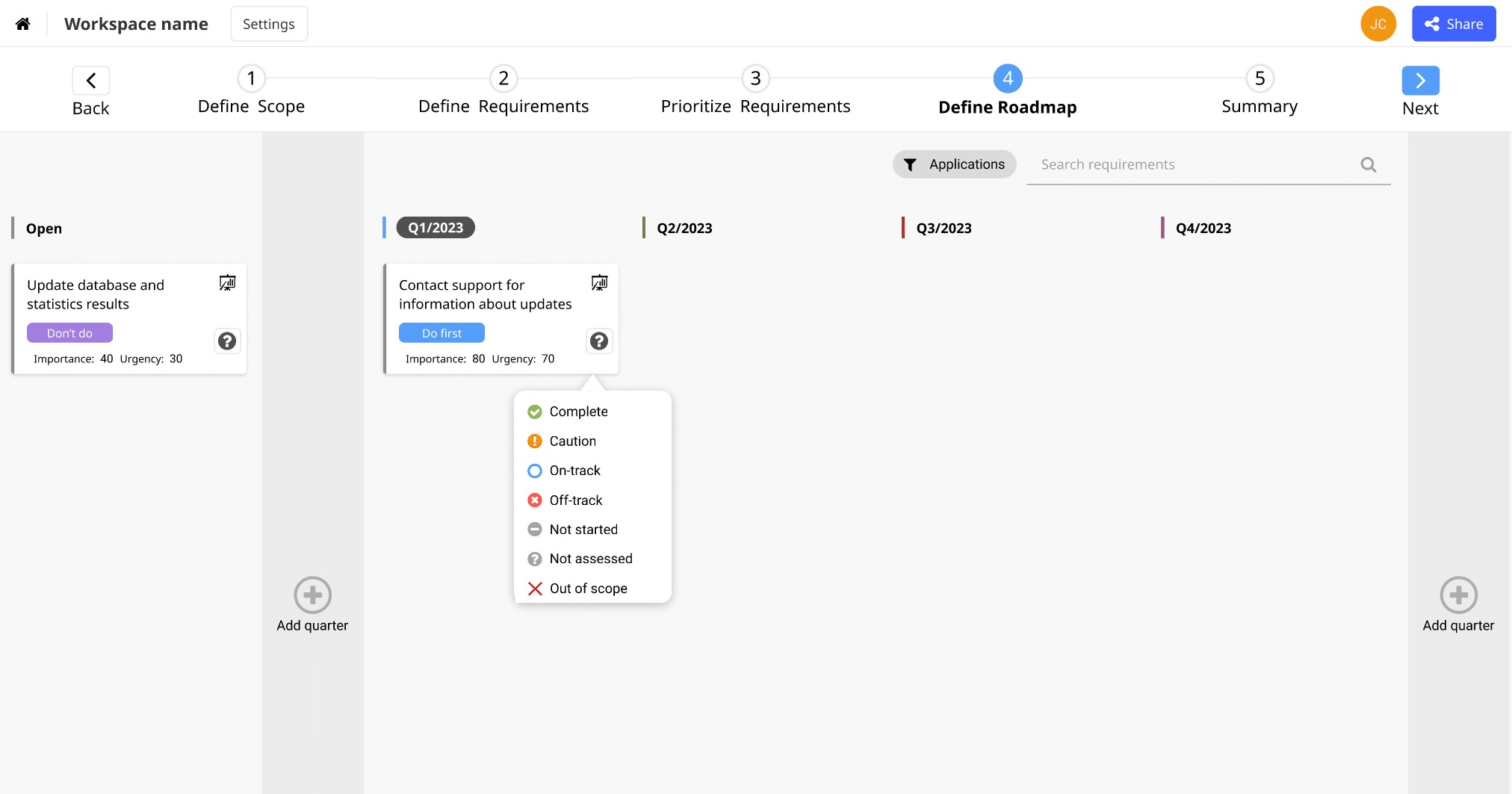Found this helpful? Share it with peers.
Introduction
Business transformation is a complex topic. To keep pace with continuous market changes, it’s important to implement corporate strategies that are constantly evolving too. Your goals therefore must be defined, and the transformation steps necessary to achieve them identified, prioritized and communicated.
And this is precisely the point where many companies struggle to translate their vision into an action plan. What they usually lack is a connector that ties theory and practice together.

Antoine de Saint-Exupéry
Roadmaps are the means of choice here. They are used to translate goals into concrete and communicable plans. Without one, your goals will hardly be achievable and your teams will likely struggle to pull together.
In this blog post, we’ll walk you through the ins and outs of strategic roadmaps. We share our key best practices on the topic and provide you with the necessary inputs as you create your strategic roadmaps to ensure the success of your EA initiatives.
What is actually a roadmap?
A roadmap is nothing more than a documentation of the steps that need to be taken in order to achieve your transformation goals. It clearly shows how and in which sub-steps your objectives are to be achieved. Roadmaps are created when strategic planning is carried out and when the results are to be visualized clearly. Thus, a roadmap is the visual result of your strategic planning process.
Why Roadmappings Matters
Roadmapping plays a crucial role in guiding organizations through their strategic transformation journeys. It serves as a structured approach to visualizing the path ahead, ensuring that all efforts are coordinated and aligned with overarching business goals. By providing a clear framework for planning and decision-making, roadmapping sets the stage for a comprehensive understanding of how various elements interact, paving the way for deeper insights into aspects such as goal alignment, flexibility, and communication.
Goal Alignment:
Strategic roadmapping ensures that every technological decision aligns with the broader business objectives, fostering a seamless integration between IT and organizational strategy.
Flexibility and Adaptability:
The extended time horizon allows for flexibility, accommodating unforeseen changes in the business landscape or technological advancements.
Communication Tool:
Beyond its technical aspects, a strategic roadmap acts as a powerful communication tool. It conveys complex architectural decisions in a comprehensible manner to stakeholders at all levels.
Technical Aspects
The technical aspects of roadmapping are essential for translating strategic goals into actionable plans. By focusing on architecture components, technology lifecycle management, and risk mitigation, these elements provide the necessary structure and detail for successful implementation. Understanding these technical facets ensures that organizations can effectively manage their resources and respond to challenges, ultimately enhancing the overall effectiveness of their strategic roadmaps.
Architecture Components:
Strategic roadmaps incorporate key architecture components, delineating how systems, applications, and data interact and evolve over time.
Technology Lifecycle Management:
It includes a meticulous plan for managing the lifecycle of technologies, ensuring that they remain current, secure, and supportive of organizational objectives.
Risk Mitigation:
Technical aspects of strategic roadmapping involve proactive risk identification and mitigation, minimizing the impact of potential challenges on the EA landscape.
In conclusion, strategic roadmapping in Enterprise Architecture is the bridge that connects technological evolution with business aspirations. It’s a dynamic, long-term guide that ensures organizations navigate the complex journey of technological advancement with clarity and purpose.
What is the purpose of roadmaps?
Roadmaps serve to communicate the developed strategy – the necessary implementation steps. And they can be leveraged for communication at all levels: from individual employees to affected business units and business management. They are used to create a unified understanding of the necessary transformation stages.
Roadmaps are a central source of information that sets out the vision, direction, priorities and progress over time. They typically consist of a series of requirements that need to be implemented. Those requirements are then often combined into milestones, for overview purposes.
Roadmaps give teams and their members the opportunity to formulate concerns, express opinions, and exchange ideas on how to implement the respective goals in an effective way.
Roadmapping is the process through which a roadmap is created, using tools such as our industry-acclaimed EA suite ADOIT. In this process, you typically define steps, milestones and resources, and schedule them for a particular point in time. When doing so, don’t forget to involve your teams and the stakeholders involved in the planning process. If the necessary people are included from the very beginning, they will be less resilient to the upcoming changes as they take place.
What are the different types of roadmaps?
There are few different roadmap variants. What they all have in common is that they represent a series of timelines. Here are some prominent examples from the field of Enterprise Architecture:
Transformation roadmaps
Transformation roadmaps clearly present and arrange strategic topics on a rough timeline, usually in quarters. Typically, the focus is either on departments or the entire organization. Essential requirements are planned for each of these areas, the implementation of which serves to achieve the set objectives.
Tipp: See an example of how you can build a sustainability transformation roadmap.
Application Roadmaps
This kind of roadmap defines the software systems that provide core functions to the company and shows their strategic development planning. At a high level, these include applications such as CRM systems, ERP systems, data analysis systems, etc. Existing software systems are evaluated and investment decisions are made on this basis. Application roadmaps are then created for the implementation that follows.
Capability Roadmap
Capabilities stand for strategic capabilities of the organization. As part of business capability map, these serve as structuring tools. At the top enterprise level, there are 30-50 capabilities. A roadmap can be created for each of them. Typically, the focus is on those capabilities whose improvements can achieve a competitive advantage on the market.
What does a roadmap actually look like?
ArchiMate-based representation
The intermediate results typical for EA are modeled as a plateau. We can say that Plateaus correspond to milestones. Each of these milestones is achieved by closing particular gaps. This is done by processing identified work packages, typically in the form of projects.
Behind each plateau, there is an architecture, or rather an architectural design, consisting of business processes, data, application components, technologies, etc. The interaction of these elements changes from plateau to plateau by closing the mentioned gaps. This is done, for example, by introducing new software, creating interfaces, introducing or optimizing processes, etc. The last plateau forms the target architecture.
For non-experts, however, the charts are not always as easy to read.

Example of an ArchiMate-based strategic roadmap visualized in the EA-Tool ADOIT
Classic Kanban roadmap style
In Kanban roadmaps, the requirements to be implemented are arranged as cards in columns on boards. This gives all stakeholders a quick overview of the tasks and the degree of implementation. Kanban roadmaps are widely used – not only in IT departments, but also in business units.
The requirements are first defined, prioritized and evaluated and then usually assigned to quarters defining when they should be executed. Each card shows the status of the implementation: completed, on-track, off-track, not started, etc.
Kanban roadmaps are usually easy to read and foster engagement – which is why they tend to be more popular in practice.
Example of a strategic kanban roadmap visualized in the EA-Tool ADOIT
Benefits of having a roadmap
First things first. Many colleagues will be interested in such roadmaps. They become one of the top deliverables of your Enterprise Architecture initiative. Of course, diagrams on the detailed architectures are no less important. However, roadmaps are the ideal entry point into your architecture transformation. If they are not too detailed, many of your colleagues will recognize them as a central point of reference.
Strategic Alignment
Roadmaps provide a visual representation of how IT plans align with broader business goals. This alignment ensures that every architectural decision is a step toward achieving organizational objectives.
Communication and Transparency
Roadmaps act as communication tools, making complex technical details accessible to stakeholders across the organization. This transparency fosters a shared understanding of the EA strategy and its progression.
Change Management
EA initiatives often involve significant changes. Roadmaps offer a structured approach to implementing changes, minimizing disruptions and ensuring a smooth transition for the entire organization.
Prioritization and Phasing
Roadmaps help in prioritizing initiatives based on business value and urgency. They outline phased implementations, allowing organizations to focus on high-impact areas first.
Risk Mitigation
By breaking down complex EA initiatives into manageable phases, roadmaps enable proactive risk management. Identifying potential challenges early in the process ensures timely mitigation strategies.
Adaptability to Change
Roadmaps aren’t static; they evolve with changing business landscapes. This adaptability ensures that EA strategies remain relevant and responsive to emerging technologies and market dynamics.
Strategic Roadmaps serve as the guiding compass for EA initiatives. They align, communicate, and navigate the complex terrain of architectural changes, contributing significantly to the overall success of enterprise architecture endeavors.
Quick-wins for successful roadmapping
Accessible Roadmapping
Make your roadmaps easily accessible to everyone on the company intranet.
Keep the roadmap up to date
Outdated metrics will hurt credibility and confidence in your roadmap. Your roadmaps will not be recognized and will not be used. Don’t stick to the roadmap when the vision has changed. External influences often make it impossible to achieve the goal. This is when the roadmap has to be adjusted.
Long term Roadmapping
Nevertheless, don’t change the roadmap too often. Otherwise, it will lose credibility and transparency.
Transparent Roadmapping
Create transparency regarding who is involved in the roadmap and how the roadmap is created. This creates trust.
Collaborative Roadmapping
Allow for feedback and participation in the creation of your roadmap. This creates a sense of togetherness. They will have to contend with much less resistance.
Elaborated Roadmapping
Underpin your roadmaps with detailed architecture designs. Keep in mind though: these should only be visible after a drill-down.
Summary
To sum it all up, a strategic roadmap is the missing link that transforms a vision into an action plan. It can help plan how to achieve a business transformation goal, while also being the preferred way to communicate key objectives and next steps with all key stakeholders. With sufficient transparency, timeliness and the right level of detail, a strategic roadmap becomes your most important deliverable for Enterprise Architecture initiatives.
If you need help with creating a strategic roadmap for your goals, don’t hesitate to get in touch with us. Our experts are happy to support you with your roadmapping efforts.







